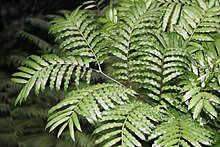
The tree ferns are arborescent (tree-like) ferns that grow with a trunk elevating the fronds above ground level, making them trees. Many extant tree ferns are members of the order Cyatheales, to which belong the families Cyatheaceae, Dicksoniaceae, Metaxyaceae, and Cibotiaceae. It is estimated that Cyatheales originated in the early Jurassic, and is the third group of ferns known to have given rise to tree-like forms. The others are the extinct Tempskya of uncertain position, and Osmundales where the extinct Guaireaceae and some members of Osmundaceae also grew into trees. In addition there were the Psaroniaceae and Tietea in the Marattiales, which is the sister group to most living ferns including Cyatheales.

The ferns are a group of vascular plants that reproduce via spores and have neither seeds nor flowers. They differ from mosses by being vascular, i.e., having specialized tissues that conduct water and nutrients and in having life cycles in which the branched sporophyte is the dominant phase.

Marattiaceae is the only family of extant (living) ferns in the order Marattiales. In the Pteridophyte Phylogeny Group classification of 2016, Marattiales is the only order in the subclass Marattiidae. The family has six genera and about 110 species. Many are different in appearance from other ferns, having large fronds and fleshy rootstocks.

Sphaeropteris medullaris, synonym Cyathea medullaris, commonly known as mamaku or black tree fern, is a large tree fern up to 20 m tall. It is distributed across the south-west Pacific from Fiji to Pitcairn Island. Its other Māori names include katātā, kōrau, or pītau.
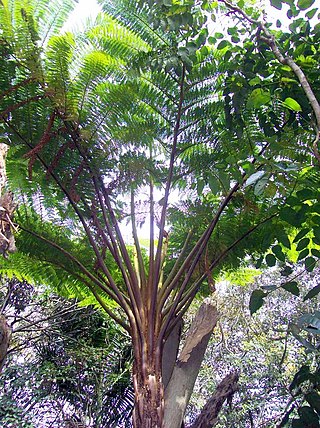
Sphaeropteris excelsa, synonym Cyathea brownii, commonly known as the Norfolk tree fern or smooth tree fern, is probably the largest fern species in the world. It is endemic to Norfolk Island, in the Pacific Ocean near Australia and New Zealand. It is named after the botanist Robert Brown (1773-1858).

Alsophila australis, synonym Cyathea australis, also known as the rough tree fern, is a species of tree fern native to southeastern Queensland, New South Wales and southern Victoria in Australia, as well as Tasmania and Norfolk Island.

Asplenium bulbiferum, known as mother spleenwort, is a fern species native to New Zealand only. It is also called hen and chicken fern and, in the Māori language, pikopiko, mouku or mauku. Its fronds are eaten as a vegetable.

Danaea kalevala is a species of fern belonging to the family Marattiaceae. It is endemic to rainforests of the Lesser Antilles islands in the Caribbean.

Hymenophyllum nephrophyllum, the kidney fern, is a filmy fern species native to New Zealand. It commonly grows on the forest floor of open native bush. Individual kidney-shaped fronds stand about 5–10 cm tall. In hot weather they shrivel up to conserve moisture, but open up again when the wet returns. This species has very thin fronds which are only four to six cells in thickness. In the Māori language they are also called raurenga.

Cranfillia fluviatilis, synonym Blechnum fluviatile, is a fern known in the Māori language as kiwikiwi. A herbaceous plant, C. fluviatilis is a "hard fern" of the genus Cranfillia in the family Blechnaceae. It was identified by Patrick Brownsey in 1979. Other common names are star fern, creek fern, kawakawa and kiwakiwa.

Zealandia pustulata is a species of fern native to eastern Australia and New Zealand. It is commonly referred to as kangaroo fern because of its mature leaves tend to resemble the shape of a kangaroo foot. It is also referred to as hound's tongue, and as kōwaowao and pāraharaha in Māori.
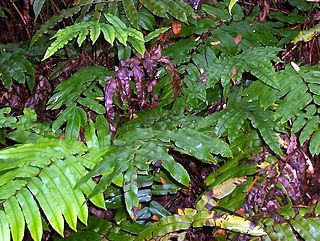
Parablechnum wattsii, synonym Blechnum wattsii, is a common terrestrial fern growing in rainforest and open forest. It is often seen near creeks in much of south eastern Australia, including Victoria, Tasmania, South Australia, New South Wales and Queensland. The specific epithet wattsii honours William Walter Watts (1856-1920). Watts was considered an authority on mosses and ferns and has more than 30 species named for him. Common names by which the species may be called are hard water fern - from its stiff leathery fronds, leech fern - as forest workers often encounter leaches while working in clusters of these ferns, hard hill fern - from the fern's habit and habitat, and red cabbage fern - from the bronze-pink colour of the young fronds resembling cooked red cabbage.

Todea barbara is known as the king fern. Occurring in moist areas of south eastern Australia, and also indigenous to New Zealand and South Africa.
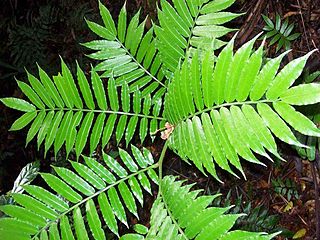
Angiopteris is a genus of huge evergreen ferns from the family Marattiaceae, found throughout the paleotropics from Madagascar to the South Pacific islands. Species of smaller stature with elongate synangia and creeping rhizomes are sometimes segregated into the genus Archangiopteris, and a once-pinnate monotypic segregate genus has been called Macroglossum, but molecular data supports inclusion of these taxa within a broad concept of Angiopteris.
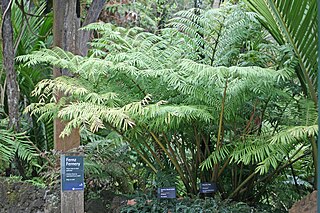
Ptisana is a genus in the eusporangiate fern family Marattiaceae, comprising species historically treated in the genus Marattia. The establishment of this genus follows the 2008 work by Andrew G. Murdock, which supported recognition of this group on the basis of genetic analysis and morphology. Ptisana can be distinguished from Marattia by the presence of distinct sutures at the point of leaflet attachment, deeply cut synangia, and the absence of labiate sporangial apertures. The name Ptisana is derived from the Latin word for pearl barley, an allusion to the shape of the synangia.
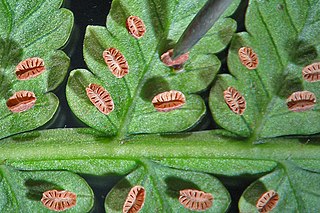
Eupodium is a genus of ferns in the family Marattiaceae native to the Neotropics. Traditionally, many taxonomists have included Eupodium within the genus Marattia. However, molecular phylogenetic studies and morphological studies of extant and fossil taxa support the recognition of Eupodium as a lineage distinct from Marattia. Morphologically, Eupodium was thought to be distinct among the Marattiaceae in only having one frond at a time, bearing awns along veins, and having stalked synangia. However, recent phylogenetic work found that an additional species native to Brazil, Eupodium cicutifolium, which lacks these characters, is also genetically in Eupodium, making the genus challenging to distinguish morphologically. Eupodium cicutifolium does occasionally have short-stalked synangia, and has spinulose spores like the other Eupodium species, but is otherwise easily mistaken for a Marattia or Ptisana. The genus currently has four recognized species.

Marattia is a small genus of primitive, large, fleshy eusporangiate ferns. It is the type genus of the family Marattiaceae, order Marattiales and class Marattiopsida. Formerly considered to be a much larger genus, genetic analysis has shown that Marattia in the broad sense was paraphyletic, and subsequently the genera Ptisana and Eupodium were split off. Except for one species in Hawaii, the genus is neotropical.
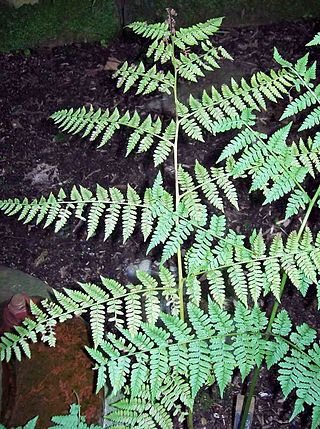
Diplazium australe, commonly known as the Austral lady fern, is a small fern occurring in eastern Australia, New Zealand and Norfolk Island. The habitat is moist shaded areas, often occurring in rainforest.
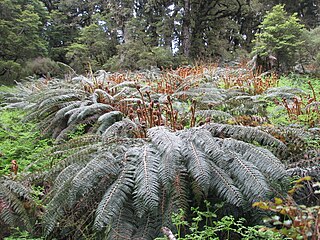
Polystichum vestitum, commonly known as the prickly shield fern or pūnui (Maori), is a hardy, evergreen or semi-evergreen ground fern.

Lygodium articulatum, commonly referred to as mangemange or Bushman's mattress, is a fern endemic to the North Island forests of New Zealand. Mangemange is an endemic species and is unique compared to other ferns in the area due to the vine–like curtain it creates in the canopy. Although the majority of the plant is found in the canopy of the surrounding forest, the roots and stem of mangemange form on the ground, meaning it cannot be classified as an epiphyte.
